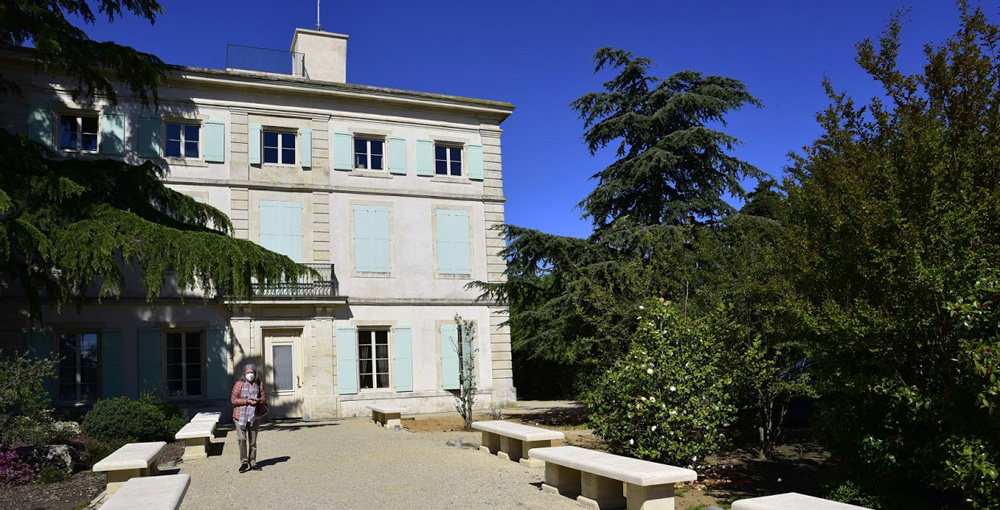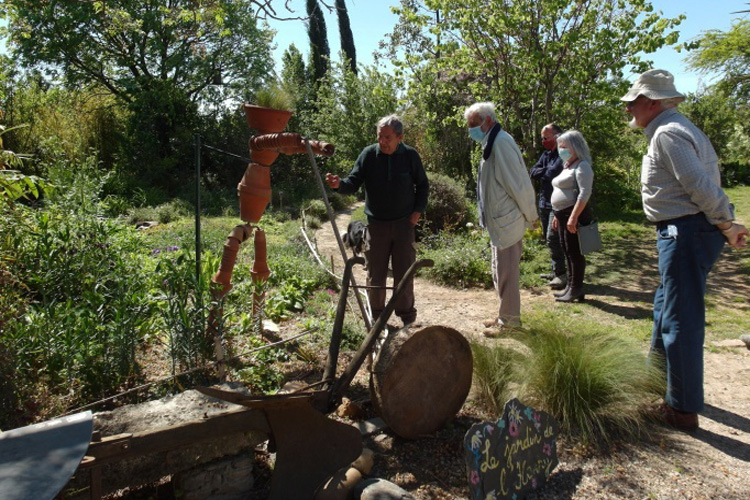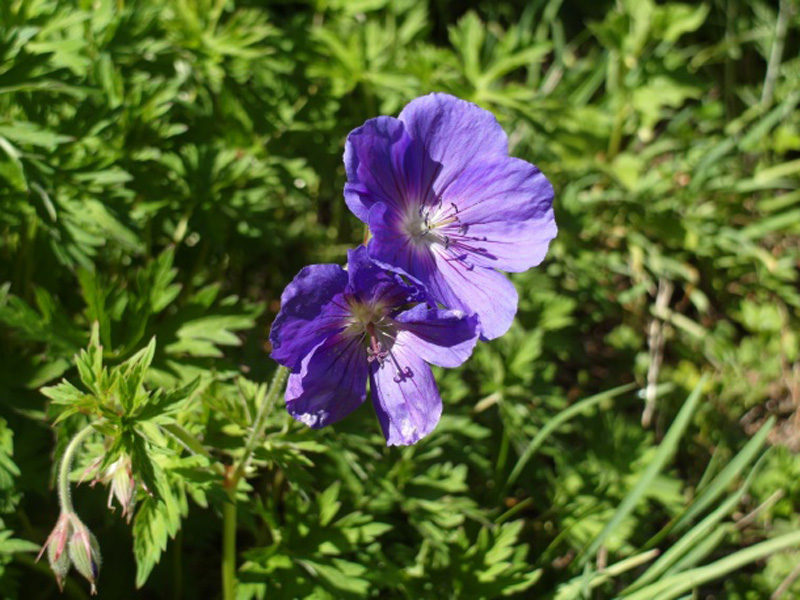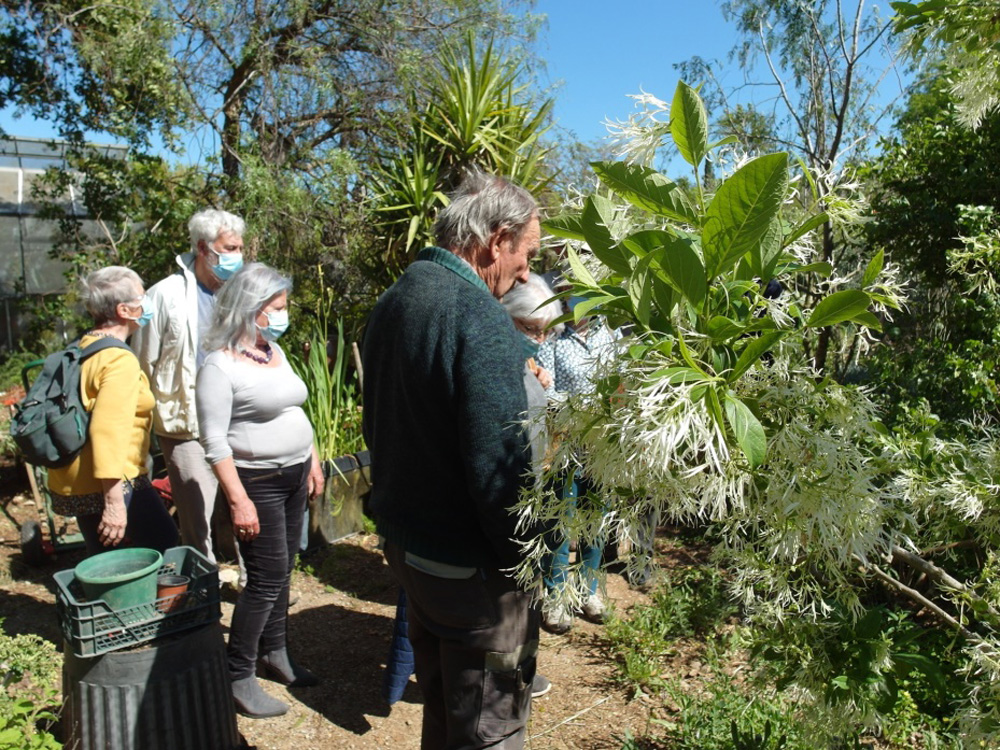May / mai 2021
Visits to the gardens of Château Pérouse and Henry Nardy / Visites aux jardins de Château Pérouse et de Henry Nardy
Click on the images to enlarge them / Cliquez sur les images pour les agrandir
Château Pérouse is situated on the Costières plateau, near Nîmes. Upon our arrival we noticed various large trees around the chateau, including several magnificent century-old cedars. The owner, Jan-Willem Voss, welcomed us and gave us a description of the Château Pérouse botanical park, and of his project.
Le domaine du Château Pérouse se situe sur le plateau des Costières, près de Nîmes. Dès notre arrivée, on note aux abords du château la présence de grands arbres dont de magnifiques cèdres plus que centenaires. Le propriétaire des lieux Jan-Willem Voss nous accueille et nous présente le parc botanique de Château-Pérouse et son projet.
The park extends to 72 hectares, 52 of which are dedicated to botanical gardens. Under development for about fifteen years, it is part of a new and ambitious research project. The intention is to gather the knowledge required for creating micro biotopes favourable to acclimatising plants from all regions with a Mediterranean climate. It already hosts four CCVS (Conservatoire des Collections Végétales Spécialisées) labelled collections (acacias, eucalyptus, melaleuca, podocarpus). The acclimatisation of plants necessitates creating an adapted landscape, recreating soil with substrates that best mimic those of the original biotopes, adapting irrigation and controlling many other parameters. Seven botanist-gardeners are employed full-time and numerous collaborations have been established with other botanical gardens.
Ce parc s’étend sur 72 hectares dont 52 sont dédiés aux jardins botaniques. En développement depuis une quinzaine d’années, il s’inscrit dans une démarche de recherche inédite et ambitieuse. Le projet vise à accumuler les connaissances nécessaires pour la création de micro biotopes favorables à l’acclimatation de plantes venues de toutes les régions à climat méditerranéen de la planète. Il accueille déjà quatre collections labellisées CCVS (acacias, eucalyptus, melaleuca, podocarpus). L’acclimatation des plantes suppose d’aménager un paysage adapté, de recréer un sol avec des substrats imitant au mieux ceux des biotopes d’origine, une irrigation adaptée et bien d’autres paramètres à contrôler. Sept botanistes-jardiniers sont employés à plein-temps et de nombreuses collaborations sont nouées avec d’autres jardins botaniques.
The tour started with a visit to the greenhouses, continuing with the experimental garden and the river garden. You can read a full report on this visit in the Garden Diaries – Château Pérouse section.
La visite a commencé par des serres, se poursuivant par les jardins d’expérimentation et le jardin de la rivière. Vous pouvez lire un compte-rendu complet de cette visite dans la rubrique Journaux de jardin – Château Pérouse.
After a picnic in the shade of the tall trees, we thanked Jan-Willem Voss and his team for their warm welcome.
Après un pique-nique sous les grands arbres nous remercions Jan-Willem Voss et son équipe pour leur chaleureux accueil.
Note that Jan-Willem Voss has generously donated 500 species of seeds for the MGI seed list. For more information about Château Pérouse, we encourage you to visit the website chateau-perouse.com, where you will also find an extensive database (over 18,000 taxa) which provides general information and links to one page per taxon of detailed information.
Rappelons que Jan-Willem Voss a généreusement fait don de 500 espèces de graines pour la Liste de Graines MGi. Pour plus d’informations, nous vous encourageons à visiter le site Web à chateau-perouse.com où vous trouverez également une vaste base de données (plus de 18 000 taxons) qui fournit des informations générales et des liens vers une page html par taxon comprenant de nombreuses informations.
In the afternoon, about ten of us strolled through the winding alleys of the Jardin de l’Henry, in Lunel, in the Hérault département. The owner, Henry Nardy, a retired former horticulturalist, collects plants from all over the world. He is passionate about his hobby and takes extreme pleasure in talking about his garden, which he regularly opens to the public.
L’après-midi, nous étions une dizaine à arpenter les allées sinueuses du Jardin de l’Henry, à Lunel, dans l’Hérault. Le propriétaire, Henry Nardy, ancien horticulteur à la retraite, y collectionne des plantes du monde entier. C’est un passionné et il prend un plaisir extrême à raconter son jardin qu’il ouvre régulièrement au public.
We were greeted by a funny scarecrow made by Henry using terracotta pots – a little humorous touch which always brings a smile to the faces of children and adults alike.
Nous sommes accueillis par un drôle de personnage, échafaudé par Henry, l’épouvantail en pots de terre cuite, petite note humoristique qui fait sourire petits et grands.
We were surrounded by a profusion of leaves, flowers, trees, onions and other bulbs. Beside the path, we admired the virginal whiteness of Chionanthus virginicus.
Partout, des feuilles, fleurs, arbres, oignons et autres bulbes. Au détour du chemin, nous admirons la blancheur virginale de Chionanthus virginicus.
In front of the entrance to the huge greenhouse is an insect hotel. Henry is an exemplary teacher, and often receives schoolchildren in his garden, in order to share with them his knowledge and his love for nature. The greenhouse contains a wealth of pampered plants grown from seed and from cuttings which Henry generously shares with others.
Avant d’entrer dans l’immense serre qui regorge de plantes semées, bouturées et chouchoutées bien au chaud et qu’il partage avec générosité, nous voici devant l’hôtel à insectes. Henry est très pédagogue et il ne manque pas de recevoir des écoliers à qui il insuffle un peu de son savoir et de son amour pour la nature.
Henry’s Garden is located at the entrance to Lunel, just before the Bois des Petits Pins, at 16, chemin creux de campagne (https://lejardindelhenry.monsite-orange.fr/index.html).
Retrouvez le Jardin de l’Henry, à l’entrée de Lunel, juste avant le bois des Petits Pins, au 16, chemin creux de campagne (https://lejardindelhenry.monsite-orange.fr/index.html)
Text: Chantal Guiraud and Roland Leclercq.
Photos: Liliane Leclercq, Hugues Pelen, Hubert Nivière, Chantal Guiraud.
English proofreading: Nanouk Pelen.
![]()










